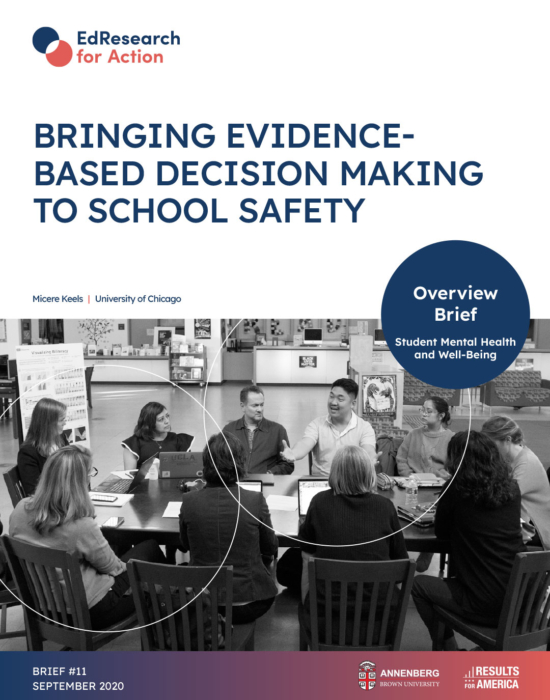STRUCTURAL SUPPORTS TO PROMOTE TEACHER WELL-BEING
This brief is one in a series aimed at providing K-12 education decision makers and advocates with an evidence base to ground discussions about how to best serve students during and following the novel coronavirus pandemic.
Doris A. Santoro | Bowdoin College
Olga Acosta Price | George Washington University
October 2021 | Brief No. 19
Central Question
What does the research say about structural supports that enable teacher well-being?
Key Insights
Breaking Down the Issue
- Burnout and demoralization are meaningfully different forms of work dissatisfaction that each affect teachers’ ability to do their jobs and influence decisions to remain in the profession.
- System and school conditions contribute to or buffer against demoralization and burnout in ways that directly affect the lives of both teachers and students.
- Evidence is growing that the pandemic has increased demoralization and burnout among many teachers.
Strategies to Consider
- A culture of mutual trust, respect, and open communication among teachers and school leaders allows them to work together to improve practices and solve problems.
- A schoolwide commitment to social and racial justice and to affirming educators’ identities can help counter the forces that contribute to high rates of burnout and turnover for teachers of color.
- School leaders who protect teachers’ time and prioritize teacher learning see higher levels of teacher satisfaction.
- Teacher involvement in the design and implementation of learning opportunities is essential to effectively improve teacher morale and student achievement.
- Trauma-informed strategies and mindfulness supports for teachers reduce stress in ways that positively affect both teachers and students. Open communication with educators and collecting data on teachers’ professional concerns allows school and district leaders to more accurately identify and address the root causes of teachers’ dissatisfaction.
Strategies to Avoid
- Wellness requires ongoing and long-term schoolwide change and should not be treated as a superficial, siloed, or short-term goal.
- Although school leaders set the direction in the school, prescribing practices without teacher involvement and monitoring compliance often result in low levels of teacher buy-in and adoption.
Breaking Down The Issue
Burnout and demoralization are meaningfully different forms of work dissatisfaction that each affect teachers’ ability to do their jobs and influence decisions to remain in the profession.
- Burnout is a temporary state where individuals have exhausted their personal and organizational resources in fulfilling their professional duties.
- Although often portrayed as the capacity for individual resilience, burnout can also be the result of unusually demanding school environments that lack appropriate organizational supports or limits.
- Teachers face high emotional demands in their daily work that can become increasingly debilitating when rates of student trauma are high.
- Demoralization is a specific form of dissatisfaction that arises when teachers feel unable to access the intrinsic rewards of their work, believe they are complicit in wrongdoing, or find that they are incapable of meeting their ethical obligations.
System and school conditions contribute to or buffer against demoralization and burnout in ways that directly affect the lives of both teachers and students.
- The quality of a teacher’s work environment plays a major role in determining teacher retention, satisfaction, and effectiveness.
- Teachers who do not feel supported in their work and who are not provided with the necessary resources are more likely to leave the profession. Turnover creates lasting negative consequences for schools in terms of teacher quality and student achievement.
- Educators experiencing personal and professional stressors are more likely to isolate and retreat from schoolwide initiatives. Studies have found that teacher burnout can contribute to lower-quality instruction and lower student achievement.
- In a survey of K-12 teachers across the United States in October 2020, teachers reported lack ofadministrative support as one of the top four variables that significantly predicted teacher burnout.
Evidence is growing that the pandemic has increased demoralization and burnout among many teachers.
- Surveys of teachers as the pandemic began highlight the rising stress and plummeting morale that many teachers have felt across the course of the year.
- With the onset of the COVID-19 pandemic, teachers across the board experienced a tremendous drop in theirself-reported “sense of success,” although the drop-off was smaller in schools with more supportive working conditions.
- A RAND survey of 1,000 teachers who left teaching during the first year of the pandemic found that the most common reason teachers cited for leaving was stress.
- During the pandemic, teachers have been charged with a multitude of extra tasks to ensure learning runs smoothly and students’ needs are met.
In a 2012 study, teacher workload was found to be a significant predictor of depression and anxiety.
- 75% of National Board Certified teachers (those who are experienced and have met many standards for excellence) reported working more hours post-COVID, with 20% reporting working more than 15 extra hours a week compared to pre-COVID.
- Online teaching in particular poses additional challenges for most teachers that will likely continue even as more schools open in person.
- As the primary contact for parents, teachers serve as the conduit for explaining controversial decisions made at the district and school level and often receive the brunt of criticism which can be emotionally draining.
- Teachers are asking for more mental health resources for themselves and their students.
- A Teach Plus and FuelEd survey of over 500 educators found that teachers want more training and resources to support their and their students’ mental health.
- Teachers who participated in focus groups during the pandemic want their schools to prioritize the well-being of teachers and students.
- Unsurprisingly, the events of the last year have only exacerbated the issues faced by educators of color.
- Educators of color tended to exit the profession at higher rates than their colleagues before the pandemic. Studies examining low retention among educators of color highlight unrecognized and uncompensated identity-based labor, disregard for their expertise and assets, educational practices that undermine their mission-driven purpose, and school cultures rooted in White supremacy.
- Survey data from educators of color in the 2020 school year found that these educators are facing high levels of race-based stress in school, which has a significant effect on their professional self-efficacy and sense of belonging.
Strategies to Consider
The strategies below should be considered as part of a comprehensive approach to creating policies and conditions that work to combat both burnout and demoralization.
A culture of mutual trust, respect, and open communication among teachers and school leaders allows teachers to work together to improve practices and solve problems.
- A study of over 400 elementary schools found that principals’ actions play a key role in developing and sustaining relational trust in schools. There are four criteria under the umbrella of relational trust:
- Respect: Genuinely listening to what others have to say and taking their viewpoints into consideration;
- Competence in Core Responsibilities: The capacity to produce desired results;
- Personal Regard: Willingness to reach out to parents, teachers, and students; and
- Integrity: Consistency between what someone says and what they do.
- Consistent structures, policies, procedures, and expectations for teachers help to develop mutually supportive relationships and encourage respect and responsibility.
Teachers who report having leadership with a system for strong communication are more likely to feel successful.
- Leaders who celebrate incremental progress in meaningful work can increase staff engagement and happiness during their workday.
- A Harvard Business Review analysis of nearly 12,000 daily surveys across seven organizations found that a sense of accomplishment, however minor, was the leading indicator of positive perceptions of work, satisfaction, and happiness.
- District leaders can leverage this “power of progress” by setting incremental goals and helping teachers achieve small successes.
- A Harvard Business Review analysis of nearly 12,000 daily surveys across seven organizations found that a sense of accomplishment, however minor, was the leading indicator of positive perceptions of work, satisfaction, and happiness.
A schoolwide commitment to social and racial justice and to affirming educators’ identities can help counter the forces that contribute to high rates of burnout and turnover for teachers of color.
- Teachers in case studies and focus groups led by Education Trust and Teach Plus called for school leaders work to build stronger school-community connections, strengthen mentorship opportunities, and compensate teachers for additional responsibilities that can come with being one of the few teachers of color in a school.
- Teachers of color are more likely to stay in schools that have a commitment to equity, social justice, and the dismantling of racism — issues that are not necessarily widely discussed or taught in many public schools and are in jeopardy in light of recent legislation in many states.
- In a 2021 survey of over 2,000 National Education Association educators of color, teachers reported the need for more guidance on how to address racial justice in the classroom.
- Affinity groups enable educators to engage in anti-racist and LGBTQIA+-affirming work specific to their racial/ethnic and sexual/gender identities in a manner that supports the well-being of the entire school community.
- Addressing the personal and professional well-being of educators of color is vital to recruitment and retention.
School leaders who protect teachers’ time and prioritize teacher learning see higher levels of teacher satisfaction.
- When school leaders are intentional about supporting teachers’ growth, teachers feel supported and are more likely to remain in the profession.
- One study that documented differences in collaboration structures and quality across 9,000 teachers in Miami- Dade public schools found that teachers who moved to schools with stronger collaborative relationships performed better and their instruction improved more quickly than when they worked in schools where collaboration was weaker.
- Systems that minimize administrative paperwork and set clear expectations for students and families can relieve pressure on teachers.
- Clearly communicating expectations for student behavior to both students and parents, and providing consistent support to teachers upholding expectations, mitigates the time teachers spend on classroom management and allows them to focus on instruction.
- A study of nearly 8,000 teachers across nine states showed that leaders play a key role in supporting teachers’ sense of success, particularly when the leaders focused on strong communication and collaboration with teachers.
![]() Teacher involvement in the design and implementation of learning opportunities is essential to effectively improve teacher morale and student achievement.
Teacher involvement in the design and implementation of learning opportunities is essential to effectively improve teacher morale and student achievement.
- Multiple studies highlight the mediating effect of teacher autonomy in determining the effectiveness of school systems and structures.
- A study of teachers across six high-poverty schools reported that they value their instructional team time when they have sufficient agency in determining how the time is used and a safe environment where they can openly examine their practice.
- Teacher morale is higher in environments where teachers have the autonomy to exercise their professional judgement, be creative, and make decisions about how best to teach their students.
![]() Trauma-informed strategies and mindfulness supports for teachers reduce stress in ways that positively affect both teachers and students.
Trauma-informed strategies and mindfulness supports for teachers reduce stress in ways that positively affect both teachers and students.
- A recent study of a trauma-informed training that aims to equip teachers with strategies to support student social-emotional learning reported significant decreases in emotional exhaustion and improvements on a variety of stress-related measures for teachers who consistently implemented the curriculum and participated in ongoing training.
- Several other well-studied programs, such as Care for Teachers, have improved outcomes for educators by advancing staff knowledge of compassion fatigue and secondary trauma, and by providing institutionalized resources to assist with prevention, management, and mitigation of symptoms.
- Mindfulness trainings for teachers that explicitly teach ways to cope with stress have been shown to reduce teachers’ self-reports of emotional exhaustion and increase teaching effectiveness.
- Schools can also facilitate teachers’ adoption of positive self-care behaviors by institutionalizing wellness routines and procedures throughout the school day.
- Many schools are experimenting with new types of employee mental health supports focused on the added stresses brought on by the pandemic.
Open communication with educators and collecting data on teachers’ professional concerns allows school and district leaders to more accurately identify and address the root causes of teachers’ dissatisfaction.
- Teacher resistance may reflect deep professional motivations and commitments.
- Patterns of teacher dissatisfaction may expose structural inefficiencies or policy flaws.
Strategies to Avoid
![]() Wellness requires ongoing and long-term schoolwide change and should not be treated as a superficial, siloed, or short-term goal.
Wellness requires ongoing and long-term schoolwide change and should not be treated as a superficial, siloed, or short-term goal.
- Designating one day, one person, or one initiative as the response to wellness will not improve teacher well-being and does not account for the diversity among teaching staff.
- Teacher wellness requires strong relationships and effective organizational systems.
- Positive school cultures take time to cultivate and a commitment of resources to sustain. This work requires individual and collective efforts as well as structural changes.
Although school leaders set the direction in the school, prescribing practices without teacher involvement and monitoring compliance often result in low levels of teacher buy-in and adoption.
- Administrators who impose preset protocols and mandatory activities or work products without the consultation of teachers create conditions in which teachers find their instructional planning time less valuable.
This EdResearch for Action Project brief is a collaboration among:





Funding for this research was provided by the Bill & Melinda Gates Foundation. The findings and conclusions contained within are those of the authors and do not necessarily reflect positions or policies of the foundation.



